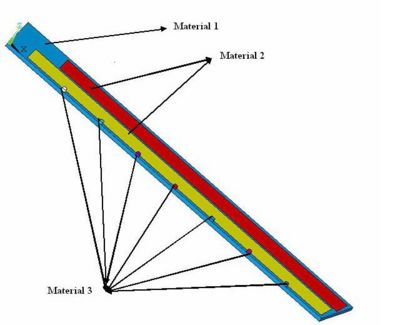Difference between revisions of "R3DC Report 2-08"
Jump to navigation
Jump to search
| Line 35: | Line 35: | ||
:<math>t = 0.05 m \equiv</math> thickness of the endplate | :<math>t = 0.05 m \equiv</math> thickness of the endplate | ||
| − | A deflection of 6 mm is expected for a 5 cm thick Aluminum endplate, after solving the above equation for <math>y</math> and inserting the given values. If a 5 cm thick stainless steel <math>(Y=2 \times 10^{11} N/m^2 )</math> endplate were used, the deflection would drop a factor of 3 from 6 mm to 2 mm due to the linear dependence of the deflection on Young's Modulus | + | A deflection of 6 mm is expected for a 5 cm thick Aluminum endplate, after solving the above equation for <math>y</math> and inserting the given values. If a 5 cm thick stainless steel <math>(Y=2 \times 10^{11} N/m^2 )</math> endplate were used, the deflection would drop a factor of 3 from 6 mm to 2 mm due to the linear dependence of the deflection on Young's Modulus. The previous work of Kevin Folkman led to a similar conclusion. |
| − | |||
| − | |||
| − | |||
==Distributed Load Deflection== | ==Distributed Load Deflection== | ||
Revision as of 17:12, 7 February 2008
Introduction
R3 Description
Geometry
Material Specifications
| Material | Youngs Modulus | Density |
| MPa | ||
| Polyeurethane Foam FR-3700 | 140 | 240 |
| Hexacell with holes | ||
| Carbon Fiber Rods | 210 | 580 |
Specific part Drawings
Endplate Deflection
Point Load Deflection
A simple calculation based on the definition of Young's modulus can yield an order of magnitude level estimate for the deflection of an endplate made from Aluminum. According to the definition of Young's modulus
where
- Young's Modulus for Aluminum
- point force/load
- width of the endplate
- deflection of endplate due to point force
- length of the endplate
- thickness of the endplate
A deflection of 6 mm is expected for a 5 cm thick Aluminum endplate, after solving the above equation for and inserting the given values. If a 5 cm thick stainless steel endplate were used, the deflection would drop a factor of 3 from 6 mm to 2 mm due to the linear dependence of the deflection on Young's Modulus. The previous work of Kevin Folkman led to a similar conclusion.
Distributed Load Deflection
Distributed load FEA
Carbon Rod Buckling
Compression
Buckling Load Threshold
Buckling FEA
=3-D Analysis
